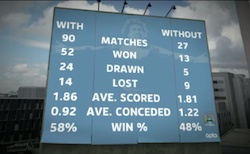
London 2012 will see the largest application so far of a trend sweeping sports broadcasting – that of using data to power broadcast analysis and video on demand, reports Adrian Pennington.
Data, such as the time and number of incidents like goals or red cards, has had a value for a number of years, but it is now being synchronised to live video feeds opening up new business models, ways in which viewers can interact live programming, or means by which rights holders can extend the reach of their brand.
Traditionally broadcasters were custodians of data, more concerned with the reward gained from TV rights. Increasingly those rights are being divided into different assets – free to air, live, mobile, internet, highlights and other subsets. There’s an understanding among savvy rights holders that the data associated with their asset has commercial value.
Data allows for the creation of unique content, which attracts consumers and therefore sponsors. Data could be used to build apps for users to select fantasy football teams or plan betting activity in a pre-match scenario. In-game data can aid understanding of tactics, performance levels and statistics. These can be user-selective rather than the limited selection available via a standard broadcast. Opinions might be shared via social networks. Post match data could be used to share highlights with friends or compare predictions.
A number of companies supply official data records of live sports events on behalf of sports rights holders to broadcasters, betting companies or even teams for training purposes. These companies manage the data, prepare it commercially and act as distributor.
Perhaps the most dynamic use of data is happening not attached to the linear broadcast stream but matched with video streamed online. Consumers are moving from passive viewers to being engaged participants in events that are unfolding by using a smartphone or tablet as a second screen at the same time as consuming a traditional TV broadcast. The opportunity is being enabled by IP while services are being driven by data and nowhere is this more prevalent than in live sports.
It is claimed that an online event where integrated data is used commands longer viewing times. This is partly because adaptive streaming delivers better quality pictures, and partly because the amount of bandwidth into people’s homes is growing continuously, but also because data helps retain viewer’s attention.
Timecodes are now stamped into the data so it matches the video enabling users to jump between concurrent live streams of events, or previous events, to view action they may have missed. This application comes into its own during an Olympics or World Cup, where two or more events are happening simultaneously.
The Olympics may well be a catalyst for change in the use of data in the industry. At the Games, an Olympic Data Feed (ODF), collected on behalf of Olympic Broadcast Services by ATOS Origin and Swiss Timing, will contain a comprehensive set of competitor information and scores from events at the Olympic venues. The BBC is one broadcaster planning to take full advantage of this.
A version of ODF for broadcasters will also be created and includes transmission information and video logging metadata to help broadcasters trigger graphics, prepare schedules and distribute information to websites/mobile.
One extension of this move to power the consumer is to allow fans in stadia to receive clips or highlights on mobile devices. Trials have been conducted at major sports venues at which spectators can connect to one of hundreds of WiFi hotspots to receive match day information, archive clips, or even a live stream of the event before them.
However it plays out, data driven sports broadcasting is setting the agenda in the year ahead.
A longer version of this article will appear in the December issue of TVBEurope.
Images courtesy of Opta







